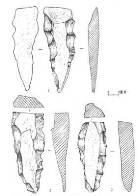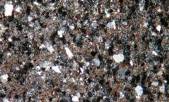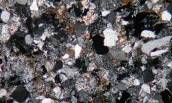



Figure 1: Map of the Linfen basin
Figure 2: Flakes from Dagudui
Figure 3: Core stone from Dagudui
Figure 4: Hammer stone from Dagudui
Mount Dagudui is situated in the Linfen Basin of South Shanxi province, northern China (35°50'28" N, 111°29' E) (Fig. 1). The quarry site lies on the south slope of the mountain and was first identified in 1984. It was excavated between 1988 and 1989 by the Shanxi Institute of Archaeology. The site covers a total estimated area of c.150,000m², of which a sample of c.300m² saw excavation. In all, a total of c.20,000 pieces of worked stone were unearthed, including flakes, cores, tool blanks and hammer stones (Figs 2-4).




Excavations at Dagudui were partial but nonetheless sufficient to allow the characterization of two distinct cultural strata. The lower of these was poorly resolved and contained only a limited assemblage of worked stone. By contrast, the upper stratum contained thousands of pieces of worked stone and it is this latter assemblage which concerns us here.
Among the thousands of artefacts recovered, c.90% are flakes from various stages in several different reduction sequences. The remaining c.10% comprises tool blanks, cores and hammer stones. The tool blanks consist of spade-shaped, knife-shaped, chisel-shaped, and spear-shaped objects, the latter dominating the Dagudui assemblage to a considerable degree (Figs 5-8).




Petrographic analysis of a sample of 9 artefacts was undertaken by Wei Chunjing from Peking University. The results show that all the sampled pieces are metamorphic sandstones, including feldspar quartz sandstone, feldspar sandstone, feldspar greywacke, greywacke and sandstone (Figs 9-13). The main mineral components identified were feldspar and quartz with small quantities of magnetite. The rocks are compact in structure, with a hardness of 6-6.5moh. Mineral particles distributed as a layered structure, making reduction easy. In Linfen Basin, these types of metamorphic sandstones seem to be only present at Mt Dagudui, and absent in all other mountainous areas. Because of the uniqueness of the material, we refer to the lithic objects found at this quarry as the Dagudui Lithics.





Dagudui has been identified as a quarry since it was discovered. Because all the artifacts there are hammer stones, tool blanks and flakes, it was regarded as a place where initial stages of manufacture, such as preform, were carried out. Most products at the site may be categorized as farming tools and craft tools based simply on the shapes of the blanks.
So far, we have only one C14 date for the site. Derived from some ash in the lower stratum, this was 2305±109 BC, which dates the deposit to the early Taosi Culture period (2500-2300BC). So, the age of the upper stratum cannot be earlier than the early period of Taosi Culture. In addition, the shapes of the blanks from Dagudui were compared with those from other sites dated from the Yangshao Culture to Erlitou Culture in the Linfen Basin. I found that the spade-shaped blank from Dagudui is quite similar in form to those from the middle and late Taosi culture (Fig. 14). The inference to be drawn from this is that the Dagudui quarry complex was in use during the middle and late Taosi Culture period (2300-1900BC).

Within the area of the Linfen Basin, there are 5 large sites dating to the Middle and Late Taosi Culture (Fig. 15). These include Taosi itself, together with Nanshi-Fangcheng, Dingcun, Houcun and Dongxu. Petrological analysis on a small number of artifacts from these sites revealed that in three cases, at Taosi, Dingcun and Nanshi-Fangcheng, use appears to have been made of a metamorphic sandstone essentially the same as that found on Mount Dagudui. In each of these three cases, an attempt was made to establish whether or not similar material might have been obtained from close at hand, in gullies or on river banks close to each site. Field investigation suggests that in all three cases, the only likely source of this raw material was Mount Dagudui. This gives us a zone of dispersal from the quarry of at least 400 km², stretching east to the Taiyue Mountains, west to the Fen River, south to the Fu River and north to the Taosi site.
At present, we have identified only the Dagudui typical objects - spear-shaped objects, and flakes at Taosi site. In fact, the distance between Dagudui and other two sites are not very far, just 15km and 5km respectively. Why have the Dagudui typical objects not been found from these two sites? My hypothesis is that only the Dagudui Lithics found at Taosi were obtained directly from Mount Dagudui, while other sites received this type of Lithics from Taosi through exchange or redistribution.
In conclusion, I argue that Taosi probably controlled the access to the special lithic raw material at Mount Dagudui. By monopolizing this important resource, the Taosi elite may have gained political and economic domination over other villages in the region.
© Internet Archaeology/Author(s) URL: http://intarch.ac.uk/journal/issue26/36/1.html
Last updated: Mon Oct 19 2009